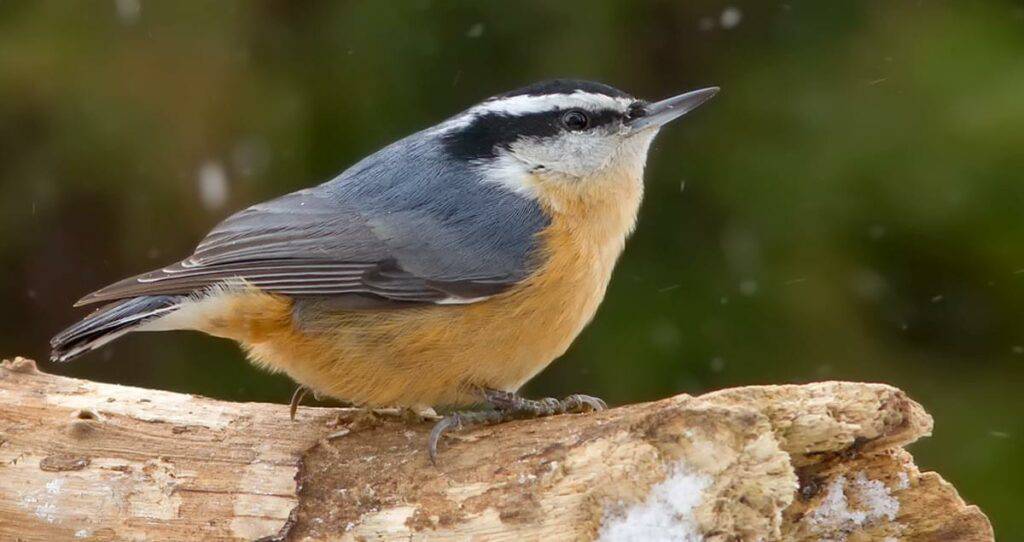Why do Red-breasted Nuthatches cover the entrance of their nests with resin?

Red-breasted Nuthatches (Sitta canadensis) are small, vocal songbirds commonly found in coniferous forests across North America, that use resin to cover the entrance of their nests. While not extensively studied in specific scientific literature, observations of this behavior provide insights into the potential reasons behind this unique nesting strategy.
Nesting Ecology of Red-breasted Nuthatches
Red-breasted nuthatches typically opt for tree cavities as their preferred nesting locations. These cavities serve as natural shelters, providing a secure and concealed space for the birds to raise their brood. The selection process involves a combination of factors, including the size and depth of the cavity, proximity to reliable food sources, and the overall suitability of the nesting site.
The birds exhibit a particular fondness for old woodpecker holes, either those naturally occurring or abandoned by their original occupants. These holes often provide the perfect dimensions for red-breasted nuthatches to build their nests. The birds may also choose existing cavities formed by decay or damage in tree trunks, demonstrating their adaptability to various nesting environments.
The nesting site’s elevation and orientation are also critical considerations. Red-breasted nuthatches favor locations that are high enough to minimize accessibility to ground predators but not so high that the nest becomes susceptible to extreme temperature fluctuations. The birds exhibit a preference for sites with an eastward or southward orientation, maximizing exposure to the morning sun and providing a thermally advantageous environment for incubating eggs and raising nestlings.
Predation and Protection
Red-breasted nuthatches, like many other bird species, face a myriad of threats to their nests. Ground-dwelling predators, such as snakes and small mammals, pose a constant danger. Additionally, arboreal threats in the form of rival bird species or curious squirrels seeking an easy meal further amplify the challenges these birds must navigate during the nesting period.
Red-breasted nuthatches have developed a keen awareness of the potential risks their nests face, and over generations, they have refined their defensive strategies. The application of resin serves as a physical deterrent, creating a formidable barrier that dissuades predators from attempting to breach the nest.
The resin itself is more than just a physical obstacle; it carries a distinctive scent that can act as a deterrent. Many predators rely on their keen sense of smell to locate nests. The resin’s odor may signal danger or an inhospitable environment, deterring potential threats from approaching the nesting site.
Interestingly, the resin-sealing behavior is not limited to active defense alone. Red-breasted nuthatches have been observed employing deceptive tactics. In some cases, they apply resin to nearby tree cavities that are not actually used for nesting. This misdirection serves to confuse and divert potential predators, enhancing the overall chances of successful reproduction.
Anti-Pathogen Properties of Resin
The use of resin to seal the entrance of their nests by red-breasted nuthatches extends beyond the realm of predator deterrence; it serves as a sophisticated defense mechanism against pathogens and parasites, contributing to the overall health and success of their nesting efforts.
Resin, a sticky and aromatic substance sourced from trees, has evolved to possess natural antimicrobial and antifungal properties. Red-breasted nuthatches, being keenly attuned to the potential risks that pathogens pose to their offspring, leverage this unique quality of resin to create a protective shield within their nesting cavities.
In the enclosed microenvironment of the nest, where warmth and moisture abound, the risk of microbial proliferation is considerable. The resin barrier acts as a formidable deterrent against the growth of harmful microorganisms, preventing the establishment of fungal colonies or bacterial infections that could jeopardize the health of the nestlings.
This anti-pathogen strategy is especially critical during the delicate stages of nestling development. Hatchlings, with their underdeveloped immune systems, are particularly susceptible to infections. By sealing the nest with resin, red-breasted nuthatches create a hygienic space that reduces the likelihood of diseases spreading within the confines of the nest.
Moreover, the aromatic compounds present in resin contribute to its antimicrobial properties. These compounds can interfere with the cellular processes of microorganisms, inhibiting their growth and providing an additional layer of defense against potential threats. The red-breasted nuthatches, through generations of instinctual behavior and learned practices, have evolved to capitalize on the beneficial qualities of resin for the well-being of their progeny.
Temperature Regulation
In regions where red-breasted nuthatches commonly breed, temperature fluctuations can be significant, ranging from chilly mornings to warmer afternoons and cold nights. The resin seal acts as a thermal insulator, helping to buffer the nest against these variations. The precise application of resin around the nest entrance creates a protective barrier that mitigates the impact of external temperatures, fostering a more constant and comfortable environment inside.
During the incubation period, when the adult birds are diligently keeping their eggs warm, the resin barrier acts as a shield against cold drafts and winds. This insulation is particularly crucial for the survival of the developing embryos. Maintaining a stable temperature within the nest ensures that the eggs receive consistent warmth, promoting healthy embryonic development and increasing the chances of successful hatching.
As the nestlings hatch and grow, the resin-sealed entrance continues to play a pivotal role in temperature regulation. Young birds are more susceptible to temperature extremes, and the resin barrier helps to create a cozy and sheltered space for them. During cool nights or unseasonably cold days, the insulation provided by the resin seal protects the nestlings from chilling, allowing them to conserve energy for growth and development.










